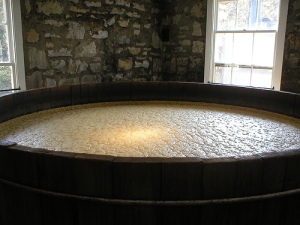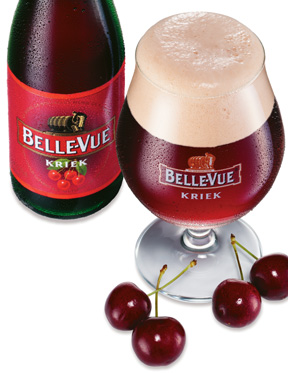I have developed an intense fascination, preoccupation … and obsession with wild yeast beers.
In my personal opinion, Lambics are quite possibly the most exciting and interesting style of beer. Ales and lagers are both fermented carefully with cultivated strands of brewer’s yeast -using tremendous control. On the other hand, Lambics are produced by spontaneous fermentation.
Although, my spontaneous nature has led to less than desired consequences in the past … I still pride myself for having such a free-spirited and adventurous personality. So what if I almost died jumping off an 80 foot cliff when I was in high school … I am still alive now, right?
I love the thrill of not knowing. I function well in chaos. I love jet setting at the very last minute. I am an adventurer and explorer. And this is why I love the concept of spontaneous fermentation.
The late and internationally renowned Beer Hunter, Michael Jackson, has referred to Lambics as the winiest of all the world’s beers.
As with many Belgian beers, Lambics are also subject to many regulations. In order to receive Lambic “certification” and label privileges, Lambics varieties must have Traditional Speciliaty Guaranteed (TSG) status.
The Traditional Speciality Guaranteed (TSG) is a trademark for an agricultural product or a foodstuff, which has a certain feature or a set of features, setting it clearly apart from other similar products or foodstuffs belonging to the same category. The product or foodstuff itmust be manufactured using traditional ingredients or must be characteristic for its traditional composition, production process, or processing reflecting a traditional type of manufacturing or processing.
So what exactly is all the traditional mumbo jumbo for Lambics?
The Lambic style can trace its roots back over 400 years, and has remained mostly unchanged from its introduction. The first written recipe is dated 1516.
Although it is impossible to confirm the origin of the word “Lambic” (“lambiek” in Flemish / Dutch), its most likely origin is the small town of Lembeek (“Lime Creek”) – a municipality close to Brussels. Today, Lambic production is concentrated in the western part of Brussels and in the nearby “Pajottenland”.
The definition of Lambic was set out in a series of Belgian Royal Decrees in the 1960′s and 70′s. These determined that Lambic must be made from at least 30% unmalted wheat at a gravity of no less than 11 Plato.
Lambic wort is usually composed of 60-70% barley malt and 30-40% unmalted wheat. Lambic beers are typically made from an original density (wort-strength) of 11.75-13.5 Plato (12.7 is the classic level) with an alcohol content of around 5.0-6.5% by volume.
Lambic beers use a variety of mashing regimes – some being very long and elaborate. The traditional method involves making two separate mashes and heating each in individual kettles.
At the boiling stage, Lambic beers use far more hops than conventional beers – sometimes up to 6 times as many hops. HOWEVER … Lambics are NOT bitter. (We will get to the flavor notes later). One of the MAJOR differentiating factors about Lambics is that they use AGED HOPS, typically aged up to three years.
The object of aging hops is to diminish their aroma, flavor, and bitterness. INSTEAD, the hops are being used solely for their secondary purpose – to ward against unwanted infections and excessive oxidation.
Unlike conventional beers which usually boil for an hour or so, the Lambic boil lasts anywhere from 3 to 6 hours. After the boil, conventional beers are usually cooled in a heat exchanger. Lambics are not. Instead, Lambic wort will spend the night in a coolship.
Then it is on to fermentation.
Unlike with conventional beers, No yeast is artificial added to Lambic wort. Instead, Lambic wort is exposed to the open air of the “Zennevalei” aka the Senne-valley. Wild yeast cells, including Bretanomyces bruxellensis and Bretanomyces lambicus (which are always in the open air in the environment of Brussels), come into the wort and eventually result in spontaneous fermentation.
Due to the spontaneous fermentation, Lambic can be brewed only in the “winter season” (October-May). In summertime, there are too much undesirable bacteria, which can infect the wort and interfere with the natural fermentation.
Most ales and lagers are produced using only a few strands of yeast, while Lambics are typically made with around 86 yeast strands.
As you can imagine, spontaneous fermentation is a very lengthy process. The microorganisms involved in the creation of Lambics must work in a specific sequence. Each microroganism depends on the metabolized products of its predecessors. It takes about two to three years for the entire process to complete and to produce a mature Lambic.
The varieties of Lambic include: Straight Lambic (Lambic Pure), Faro, Fruit, Mars … and MY ABSOLUTE FAVORITE, Gueuze.
Straight Lambic: Cloudy, uncarbonated (almost still), unsweetened and unblended draught beer. Generally three years old. Extremely hard to find. It is served in only one or two two cafés in Brussels and a handful in the area of production.
Faro: Unblended three-year-old lambic sweetened with rummy-tasting dark candy sugar and occasionally spiced. Also hard to find and typically found on draught. Sometimes available at Lambic cafés in a do-it-yourself version where sugar is added directly at the table by the drinker and crushed into the drink with a mortar. Faro was once the restorative for the working man in Brussels.
Mars: Traditionally referred to a weaker beer made from the second runnings of a Lambic brewing. It is no longer commercially produced.
Fruit: Lambic with the addition of whole fruit or syrup. Most common fruits include sour cherry (kriek), raspberry (framboise), peach (pêche), blackcurrant (cassis), grape (druif), or strawberry (aardbei). Rarer fruit lambic flavorings include apple (pomme), banana, pineapple, apricot, plum, cloudberry, and lemon. Fruit lambics are usually bottled with secondary fermentation. Lambic-based Kriek beers are the most traditional fruit brews.
Gueuze: Bottled, sparkling and easier to find. Made by blending young Lambic (6 months to 1 year old) with more mature vintages (2 to 3 years old). It is then bottled for a second fermentation (similar to Champagne and is actually bottled in Champagne bottles). The word Gueuze (hard “g”, and rhymes with “firs”) may have the same etymological origins as the English words gas and ghost, and the Flemish gist (“yeast”), referring to carbonation and rising bubbles.
Last spring – while drinking and eating my way through Chicago, I was introduced to the gueze. My first experience was with Lindeman’s Cuvee Rene – which absolutely blew my mind. I loved it so much, in fact, that I opted to drink Cuvee Rene for my last birthday (the quarter of a century celebration) in lieu of Champagne or sparkling wine. To this day, I find it very hard to choose between Gueuze and Champagne!
Now that I have posted the educational mumbo jumbo about Lambics … I look forward to tasting and blogging about some of my favorites in the (very) near future!
CHEERS!
SOURCES: Michael Jackson’s GREAT BEERS OF BELGIUM, Wikipedia

































November 20, 2008 at 10:20 pm
That Belle Vue Kriek looks heavenly! Wonder if they sell it here in Colorado. I’m a big sucker for sour ales these days and that might hit the spot. Recently had an Oud Beersel Kriek Ale from Belgium – mmmmm good stuff.
November 21, 2008 at 1:17 am
Faro is fun. The sugar they add gets fermented in the bottle. If you drink a young bottle, it’s very sweet. An old bottle is a lot dryer and has more wild yeast and bacteria flavours. Too old and the bottle blows up.
I look forward to hearing a great story about how you jumped of an 80′ cliff, survived an exploding beer, and still got drunk afterwards.
Faro is great if you want to live dangerously (and by dangerous I don’t mean life-threatening).
November 21, 2008 at 10:53 am
I’ve had a lot of the common fruit lambics before but I tried my first gueuze lambic a few months ago at a beer tasting and I was a big fan. Loved the sour taste, but unfortunately it’s not available anywhere in CT at the moment as far as I know.
Great article.
November 21, 2008 at 1:23 pm
Damon -
Unfortunately, my story does not involve getting drunk afterwards … hehe. I used to go cliff jumping a lot during the summer in high school (upstate NY – Catskill region). One time, my type-A personality led to a need to “one-up” all my friends and leap off what I was told was an 80ft cliff (however, kids tend to exaggerate in high school so it might have been shorter). I hit the water at an angle, which forced both my contacts out of my eyes … knocked the wind out of me … and temporarily paralyzed my body.
This was really scary for me because I could not breathe or swim … so essentially I was gonna drown. Luckily, some people that we were not with at the time jumped in from the opposite side and pulled me out of the water. In the subsequent days, the whole right side of my body was purple (I am talking about a body sized bruised) and my ribs were also bruised. I could barely walk for 3 days.
ANYWAYS. There is your story! CHEERS!
November 21, 2008 at 10:21 pm
Ashes – great story!
I am sad to say I didn’t have my first lambic until this year, but both dad and I absolutely loved it. We’re always on lambic alert every time we go to a beer store now. It’s hard not to love something that you know so much hard work went into.
Lambics are also a great pairing with pie noon (midnight, the perfect time for a slice of pie)!
November 22, 2008 at 8:47 am
So you’re out of the closet as a lambicophile – welcome to the club! Now you have to climb aboard a Brussels-bound plane and pay a visit to the Van Roys at Cantillon. There is simply no other labmic experience that compares.
You might also be interested in the lambic story I wrote for Saveur magazine a few years back. They’ve just recently posted it online here: http://saveur.com/article/Drink/A-Beer-Called-Lambic
And lastly, also timely, try a gueuze with your Thanksgiving turkey this year. It’s a remarkable food and beer combination.
Oh, and Dr. Beer Love, thanks for introducing me to the concept of pie noon. I shall never utter the word midnight again!
November 22, 2008 at 4:33 pm
So…scratch my last comment…today, I ventured to a beer store a bit farther than the one I regularly go to…and I found a gueuze lambic!!
December 5, 2008 at 11:11 pm
Nicely written post on Lambic beers. I’ll admit to not having any Lambic beers – yet! Currently I’m on something of an Abbey Ale quest, so maybe this will be next. I’ll refer back when the time is right!
December 9, 2008 at 10:17 am
[...] sure about Belgian styled beers or how the are made. The Beer Wench has a nice primer about Belgian styled beers along with some very nice [...]
January 5, 2009 at 4:53 pm
[...] who have read my post entitled “My Obsession With Wild Beers” are aware that Lambics are my favorite style of beer … with gueuze being my favorite style of [...]
July 2, 2009 at 9:15 pm
Well, I came back to say I finally had one! Yum! Lindemans Raspberry.
July 13, 2009 at 10:04 am
[...] The Beer Wench does a great post about Lambics in general. Great read. [...]